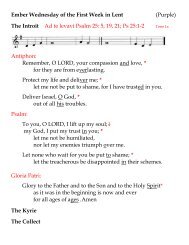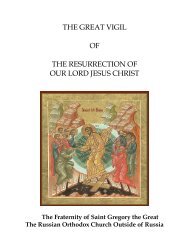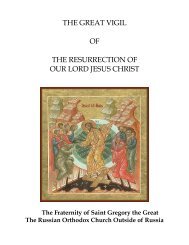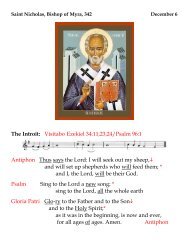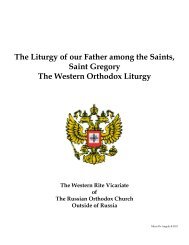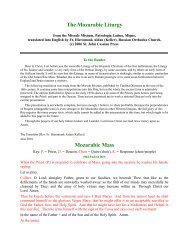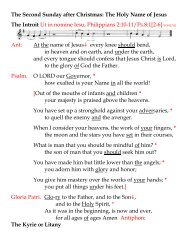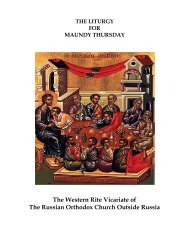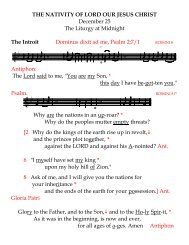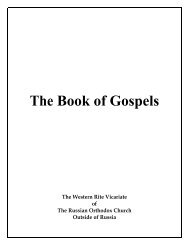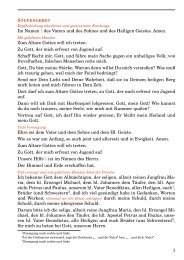You also want an ePaper? Increase the reach of your titles
YUMPU automatically turns print PDFs into web optimized ePapers that Google loves.
ack to early Egyptian Christian tradition while the second part, where each paragraph (see pp. 24-25qqq) begins with the words,<br />
“Remember, O Lord…” Noteworthy is the fact that in this second part <strong>of</strong> the Diptychs, the refrains sung by the Choir or people are absent.<br />
In the 1938 Slavonic edition <strong>of</strong> the <strong>Liturgy</strong> <strong>of</strong> <strong>St</strong>. James, the Diptychs were considerably abridged; abridgement is also possible here, at the<br />
discretion <strong>of</strong> the Bishop.<br />
[xiv] <strong>The</strong> petition for rains and fruits <strong>of</strong> the earth is said in April (<strong>St</strong>. <strong>Mark</strong>’s Day); that for the rivers (or in Egypt the Nile) “rising to their<br />
measure” in June (<strong>St</strong>. Cyrill <strong>of</strong> Alexandria, June 9).<br />
[xv] <strong>The</strong> Deacon’s prayers for the departed would be said aloud only on days when this is permitted. Otherwise they would be said secretly.<br />
[xvi] Another peculiarity <strong>of</strong> the <strong>Liturgy</strong> <strong>of</strong> <strong>St</strong>. <strong>Mark</strong> is the absence <strong>of</strong> the verse “Blessed is He that cometh in the name <strong>of</strong> the Lord,” which<br />
never had been part <strong>of</strong> the “Holy, Holy, Holy” in the Church <strong>of</strong> Alexandria. Earlier manuscripts did not have the Priest say the “Holy, Holy,<br />
Holy” secretly before it was sung by the choir or people. After the words “the majesty <strong>of</strong> Thy glory” (bottom top <strong>of</strong> p. qqq), he continued<br />
at once with the exclamation “At all times,” as on p. qqq.<br />
[xvii] One <strong>of</strong> the most remarkable elements in the <strong>Liturgy</strong> <strong>of</strong> <strong>St</strong>. <strong>Mark</strong> is this extensive dialogue between the Priest and Deacon at the<br />
consecration <strong>of</strong> the Holy Gifts. Although it appeared in written form at a late date, it can only have developed over a protracted period,<br />
during which this <strong>Liturgy</strong> was in constant use. Those who know the Slavic versions <strong>of</strong> the Liturgies will recognise this as the point where the<br />
Prayer <strong>of</strong> the Third Hour—with its verses—has been inserted, and is recited by the Celebrant with the Deacon saying the verses. This was a<br />
development that began in Alexandria, either at the same time as this dialogue form <strong>of</strong> the Prayer <strong>of</strong> Consecration was developing or after it<br />
had become customary. In this case it seems likely that the clergy <strong>of</strong> Alexandria felt the need for some kind <strong>of</strong> amplification in the <strong>Liturgy</strong> <strong>of</strong><br />
<strong>St</strong>. John Chrysostom, and thus exerted a lasting influence on it, an influence stemming from the <strong>Liturgy</strong> <strong>of</strong> <strong>St</strong>. <strong>Mark</strong>.<br />
[xviii] <strong>The</strong> Lord’s Prayer is thus said twice, once secretly by the Priest, then sung or recited by all while the Priest says another prayer, as in<br />
the <strong>Liturgy</strong> <strong>of</strong> <strong>St</strong>. James; the more ancient practice was for the Priest and congregation to say the Lord’s Prayer a single time, together.<br />
[xix] This Litany has a peculiar form <strong>of</strong> “One is Holy,” although in the latest manuscripts it was replaced by the familiar text as in the<br />
<strong>Liturgy</strong> <strong>of</strong> <strong>St</strong>. John Chrysostom.<br />
[xx] <strong>The</strong> Litany “Aright! Having partaken,” etc., is included as part <strong>of</strong> the <strong>Liturgy</strong> <strong>of</strong> <strong>St</strong>. <strong>Mark</strong> both in the version <strong>of</strong> <strong>St</strong>. Nectarios and in that<br />
edited from the ancient manuscripts in Brightman’s “Liturgies Eastern and Western.” However, in Pr<strong>of</strong>. Foundoulis’ 1977 edition this litany<br />
has been left out, on the grounds no doubt <strong>of</strong> its being a later Byzantinization. Nevertheless, the text <strong>of</strong> this litany as given differs enough<br />
from that in the Liturgies <strong>of</strong> <strong>St</strong>. John Chrysostom and <strong>St</strong>. Basil to give it a peculiar form found only in the <strong>Liturgy</strong> <strong>of</strong> <strong>St</strong>. <strong>Mark</strong>, and this also<br />
shows that, although it was added by analogy with other Liturgies, the addition must have taken place at a fairly distant period <strong>of</strong> time.<br />
In the version preserved by Patriarch Meletios Pegas and <strong>St</strong>. Nectarios <strong>of</strong> Pentapolis, the ending <strong>of</strong> the <strong>Liturgy</strong> seems to have been<br />
mangled. <strong>The</strong>re is some indication that this may have occurred through the pages being bound together in the wrong order, so that the<br />
second page <strong>of</strong> the manuscript became the last, and the Prayer <strong>of</strong> the First Antiphon (for the Congregation) was thus given as a dismissal.<br />
<strong>The</strong> present translation therefore follows the ancient manuscripts and Pr<strong>of</strong>. Foundoulis’ edition in giving the text <strong>of</strong> the conclusion <strong>of</strong> the<br />
<strong>Divine</strong> <strong>Liturgy</strong>.



